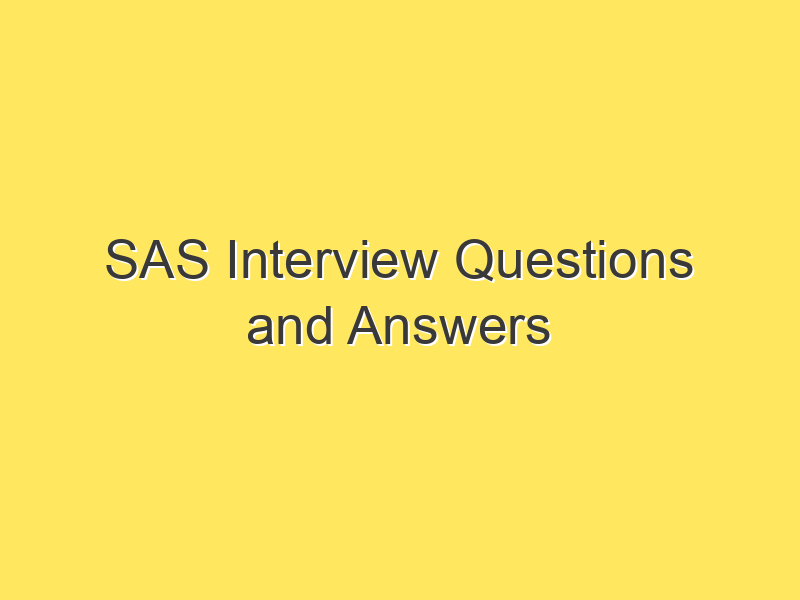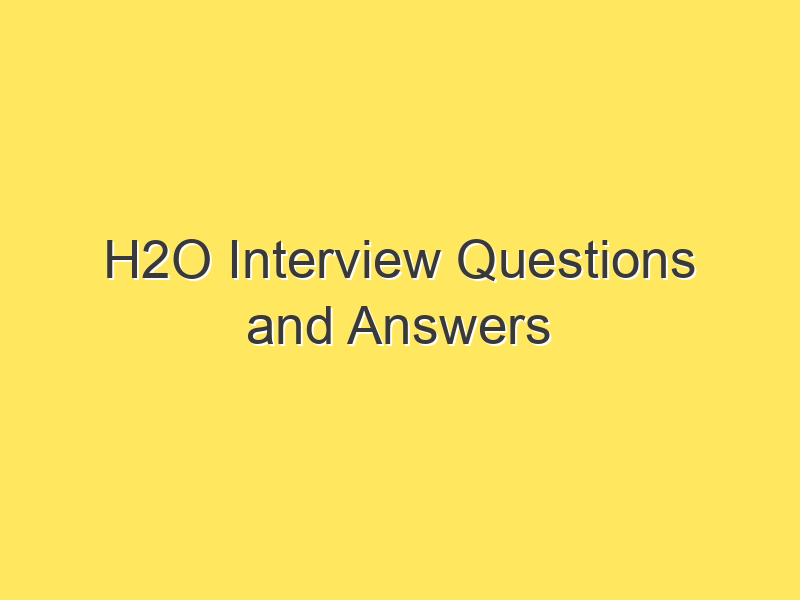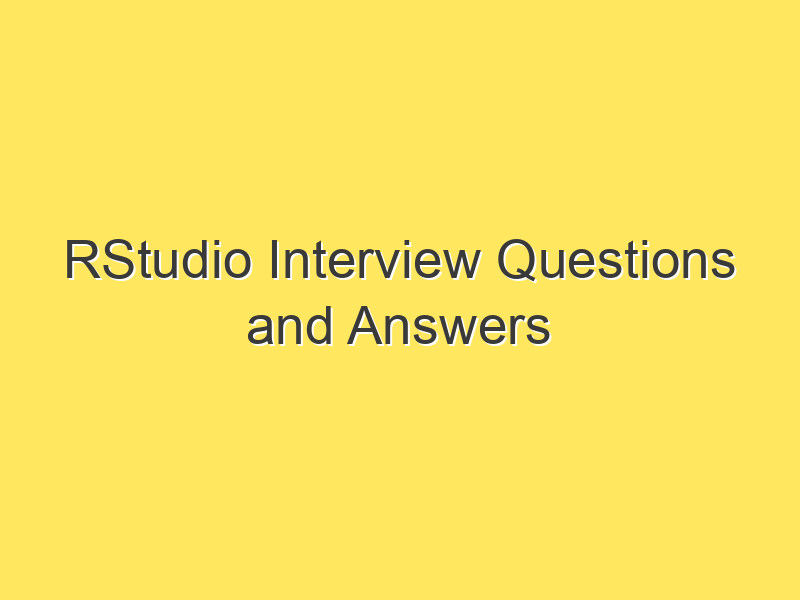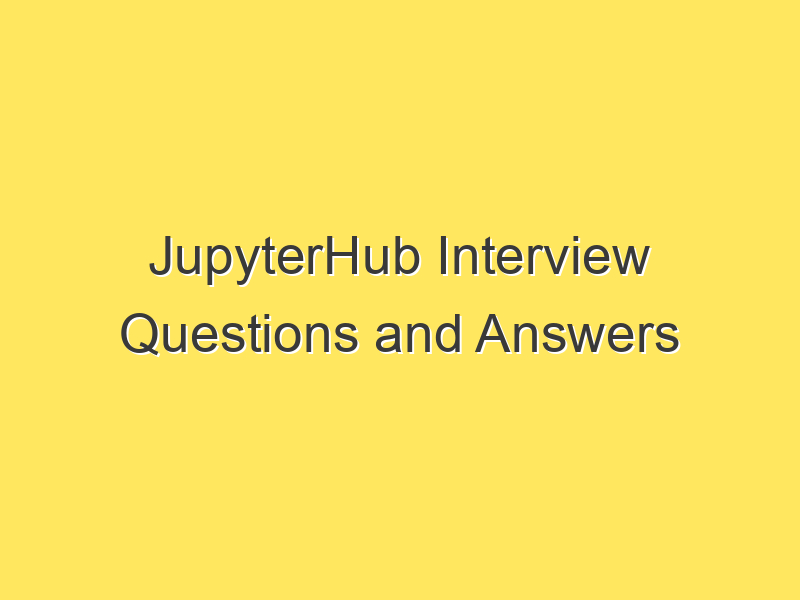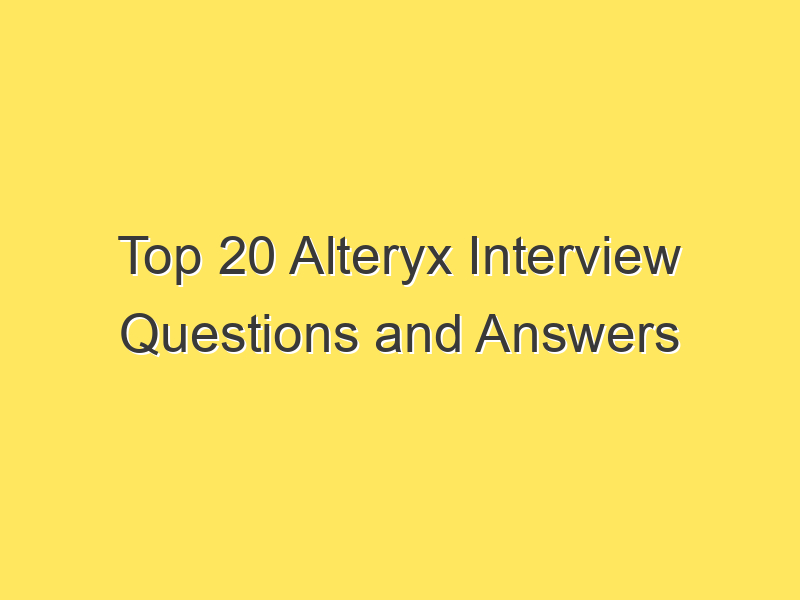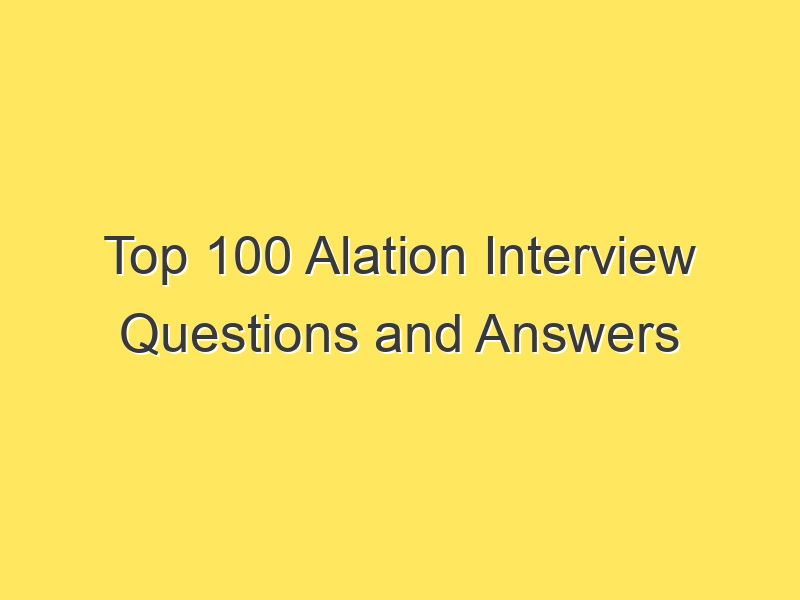Top 100 Jenkins Interview Questions Answers with Examples 2023
Jenkins is a widely used open-source automation server that simplifies and automates various aspects of software development, including building, testing, and deploying applications. If you’re preparing for a Jenkins interview, this comprehensive list of questions and example answers will help you ace the interview and showcase your Jenkins expertise.
Post Contents

1. What is Jenkins, and why is it used?
Answer: Jenkins is an open-source automation server that automates repetitive tasks in the software development lifecycle. It’s used for continuous integration, continuous delivery, and continuous deployment to improve software quality and speed up development.
2. How can you install Jenkins?
Answer: Jenkins can be installed on various platforms, including Linux, Windows, and macOS. Here’s an example of installing Jenkins on a Linux system using the official repository:
sudo apt update
sudo apt install openjdk-11-jdk
wget -q -O - https://pkg.jenkins.io/debian/jenkins.io.key | sudo apt-key add -
sudo sh -c 'echo deb http://pkg.jenkins.io/debian-stable binary/ > /etc/apt/sources.list.d/jenkins.list'
sudo apt update
sudo apt install jenkins
3. Explain the concept of a Jenkins pipeline.
Answer: A Jenkins pipeline is a suite of plugins that allows you to define and automate the entire software delivery process, from code building and testing to deployment. It’s defined as code and can be version-controlled and shared among teams.
pipeline {
agent any
stages {
stage('Build') {
steps {
// Build your code here
}
}
stage('Test') {
steps {
// Run tests here
}
}
stage('Deploy') {
steps {
// Deploy your application
}
}
}
}
4. What is a Jenkins job or project?
Answer: A Jenkins job or project is a configuration that defines a particular task in Jenkins, such as building a project, running tests, or deploying an application. It’s a fundamental unit of work in Jenkins.
5. Explain the difference between a Jenkins freestyle project and a Jenkins pipeline.
Answer: A Jenkins freestyle project is a traditional project type that offers a simple and GUI-based way to configure and execute jobs. A Jenkins pipeline is defined as code and allows for more complex workflows and version-controlled definitions.
6. How do you trigger a Jenkins job automatically?
Answer: You can trigger Jenkins jobs automatically using several methods, such as:
- SCM Polling: Jenkins can poll your version control system (e.g., Git) for changes and trigger a build when changes are detected.
- Webhooks: Set up webhooks in your version control system to notify Jenkins when changes occur.
- Scheduled Builds: Use the built-in scheduling feature to trigger jobs at specific times.
7. What is a Jenkins build agent or executor?
Answer: A Jenkins build agent (or executor) is a worker machine that executes Jenkins jobs. It allows for parallel execution of jobs on multiple agents, distributing the workload.
8. How can you restrict a Jenkins job to run only on specific agents?
Answer: You can restrict a Jenkins job to run on specific agents by using the agent directive in your pipeline script or by configuring node labels in the job configuration.
Example using the agent directive:
pipeline {
agent {
label 'my-special-agent'
}
stages {
// Define your stages here
}
}
9. What is a Jenkinsfile, and why is it important?
Answer: A Jenkinsfile is a text file that defines a Jenkins pipeline using Groovy-based DSL. It allows you to define the entire pipeline as code, which can be version-controlled and shared, ensuring consistency and repeatability.
10. Explain the role of the Jenkinsfile in a Jenkins pipeline.
Answer: The Jenkinsfile is the configuration file that defines the entire Jenkins pipeline. It specifies the steps, stages, agents, and other configuration details required to build, test, and deploy an application.
11. How do you create a parameterized Jenkins job?
Answer: You can create a parameterized Jenkins job by configuring the job to accept parameters. For example, you can define string, choice, or Boolean parameters that users can input when triggering the job.
Example of a parameterized job:
pipeline {
parameters {
string(name: 'ENVIRONMENT', defaultValue: 'dev', description: 'Target environment')
choice(name: 'BRANCH', choices: ['main', 'feature', 'bugfix'], description: 'Select branch to build')
booleanParam(name: 'CLEAN_BUILD', defaultValue: true, description: 'Clean workspace before build')
}
stages {
// Define stages and use parameters as needed
}
}
12. How do you pass parameters between Jenkins jobs?
Answer: You can pass parameters between Jenkins jobs using the “Parameterized Trigger” plugin or by using shared resources like files or environment variables.
13. What is Jenkins Job DSL, and how does it work?
Answer: Jenkins Job DSL is a plugin that allows you to define Jenkins jobs programmatically using Groovy code. It simplifies job creation and management, especially for large-scale Jenkins setups.
14. How can you secure Jenkins?
Answer: You can secure Jenkins by:
- Using authentication mechanisms (e.g., LDAP, OAuth, or Matrix-based security).
- Configuring authorization to control user access.
- Using role-based access control (RBAC) to assign permissions.
- Enabling security plugins and regularly updating Jenkins.
15. Explain how you can integrate Jenkins with version control systems like Git.
Answer: You can integrate Jenkins with Git by configuring a Jenkins job to connect to your Git repository. Use Git hooks or webhooks to trigger builds on code changes. Jenkins can also clone the Git repository, build code, and report results.
pipeline {
agent any
stages {
stage('Checkout') {
steps {
// Checkout code from Git
git credentialsId: 'your-credentials', url: 'https://github.com/your-repo.git'
}
}
stage('Build and Test') {
steps {
// Build and test your code
}
}
}
}
16. What are Jenkins plugins, and why are they important?
Answer: Jenkins plugins are extensions that add functionality to Jenkins. They are essential for customizing and extending Jenkins to support various tools, integrations, and workflows.
17. How can you update Jenkins plugins?
Answer: You can update Jenkins plugins from the Jenkins dashboard by navigating to “Manage Jenkins” > “Manage Plugins.” From there, you can select the plugins to update and click “Download now and install after restart.”
18. What is the purpose of the Jenkins Script Console?
Answer: The Jenkins Script Console allows administrators and users with appropriate permissions to execute arbitrary Groovy scripts directly within Jenkins. It’s useful for troubleshooting, diagnostics, and automation.
19. Explain how you can automate the creation of Jenkins jobs using the Job DSL plugin.
Answer: You can automate the creation of Jenkins jobs using the Job DSL plugin by writing Groovy scripts that define job configurations. These scripts can create, update, or delete jobs as code, ensuring consistent job definitions.
20. What is a Jenkins pipeline shared library, and why is it useful?
Answer: A Jenkins pipeline shared library is a collection of reusable Groovy code that can be used across multiple pipeline scripts. It simplifies pipeline development and promotes code reuse.
21. How do you configure email notifications in Jenkins?
Answer: To configure email notifications in Jenkins, you can:
- Install and configure the “Email Extension” plugin.
- Set up SMTP server details.
- Add a post-build action to send email notifications upon job completion.
22. How can you archive artifacts in Jenkins, and why is it important?
Answer: You can archive artifacts in Jenkins by using the “Archive the artifacts” post-build action. Archiving artifacts allows you to retain build artifacts for reference, deployment, and debugging.
23. Explain how to trigger downstream jobs in Jenkins.
Answer: To trigger downstream jobs in Jenkins, you can use the “Build other projects” post-build action in your job configuration. Specify the downstream project(s) to trigger upon successful or unstable builds.
24. How can you schedule periodic builds in Jenkins?
Answer: You can schedule periodic builds in Jenkins using the “Build periodically” option in the job configuration. Use a cron-like syntax to specify the build schedule.
Example: To build every day at 3:00 AM, use H 3 * * *.
25. What is Jenkins Blue Ocean, and how does it enhance the Jenkins user interface?
Answer: Jenkins Blue Ocean is a modern user interface that simplifies pipeline visualization and management. It provides a more intuitive and user-friendly experience for creating and monitoring pipelines.
26. How do you run a Jenkins job on multiple platforms or configurations?
Answer: You can run a Jenkins job on multiple platforms or configurations using a matrix project or by defining multiple agent sections in your pipeline.
Example using matrix:
pipeline {
agent none
stages {
stage('Test on Different Configurations') {
matrix {
axes {
axis {
name 'PLATFORM'
values 'Linux', 'Windows', 'macOS'
}
}
stages {
stage('Build and Test') {
steps {
// Build and test for each platform
}
}
}
}
}
}
}
27. Explain how to archive and manage build artifacts in Jenkins.
Answer: To archive and manage build artifacts in Jenkins, you can use the “Archive the artifacts” post-build action. Specify which files or directories to archive, and they will be available for download and further processing.
28. How do you trigger a Jenkins job remotely?
Answer: You can trigger a Jenkins job remotely by using the Jenkins Remote API or by configuring webhooks in your version control system to send POST requests to the Jenkins job URL.
29. What is Jenkins Agentless Architecture?
Answer: Jenkins Agentless Architecture allows you to run Jenkins pipelines without agents. It’s useful for scenarios where you don’t need a dedicated agent, such as running on the master node or in containerized environments.
30. How can you back up and restore Jenkins configurations and data?
Answer: You can back up and restore Jenkins configurations and data by copying the Jenkins home directory, which contains configuration files and data. Regular backups are essential to prevent data loss.
31. What is the role of Jenkins Credentials and how do you manage them?
Answer: Jenkins Credentials are used to securely store sensitive information such as passwords and API tokens. You can manage credentials in Jenkins by navigating to “Manage Jenkins” > “Manage Credentials,” where you can add, update, or delete credentials.
32. Explain how you can parallelize builds in Jenkins.
Answer: You can parallelize builds in Jenkins using the “parallel” directive in your pipeline script. Define multiple stages or steps within the “parallel” block to run them concurrently.
Example using parallel steps:
pipeline {
agent any
stages {
stage('Parallel Build and Test') {
parallel {
stage('Build') {
steps {
// Build code
}
}
stage('Test') {
steps {
// Run tests
}
}
}
}
}
}
33. What is the difference between a Jenkinsfile and a Jenkins Pipeline DSL script?
Answer: A Jenkinsfile is a text file that contains the entire pipeline definition and can be stored in source control. A Jenkins Pipeline DSL script is a Groovy script used within a pipeline and is typically defined within the Jenkins job configuration.
34. How can you pass environment variables to a Jenkins job?
Answer: You can pass environment variables to a Jenkins job using the “Build Environment” section in the job configuration or by using the “withEnv” step in a pipeline script.
Example using “Build Environment” in job configuration:
export MY_ENV_VAR=my_value
In Jenkins pipeline:
pipeline {
agent any
environment {
MY_ENV_VAR = 'my_value'
}
stages {
stage('Build') {
steps {
// Access MY_ENV_VAR here
}
}
}
}
35. Explain how you can trigger a Jenkins job remotely using a token.
Answer: You can trigger a Jenkins job remotely using a token by providing the token as a parameter in the job’s URL. For example:
http://jenkins-server/job/job-name/build?token=your-token
36. What is the Jenkins Job Queue, and how does it work?
Answer: The Jenkins Job Queue is a mechanism that manages the execution order of Jenkins jobs. When a job is triggered, it’s placed in the queue until an available executor is ready to run it.
37. How do you view the build history and console output of a Jenkins job?
Answer: You can view the build history and console output of a Jenkins job by navigating to the job’s build history page and clicking on a specific build number. The console output provides detailed information about the build process.
38. Explain the purpose of the “Quiet Period” in Jenkins.
Answer: The “Quiet Period” in Jenkins is a delay period before a new build is triggered after a change is detected in the version control system. It allows time for multiple changes to be detected and grouped into a single build, reducing unnecessary builds.
39. How can you archive old builds in Jenkins?
Answer: You can archive old builds in Jenkins by configuring the “Discard Old Builds” option in the job configuration. Specify criteria such as the number of builds to keep, the number of successful builds to keep, or a specific age threshold.
40. Explain how you can implement a canary deployment strategy in Jenkins.
Answer: You can implement a canary deployment strategy in Jenkins by deploying a new version of your application to a subset of users or servers and monitoring its performance and stability. Gradually roll out the new version to a larger audience if it performs well.
41. What is the Jenkins Pipeline Syntax (Declarative vs. Scripted)?
Answer: Jenkins Pipeline Syntax includes both Declarative and Scripted syntax. Declarative provides a simpler and more structured way to define pipelines, while Scripted offers more flexibility but with a steeper learning curve.
Example of Declarative syntax:
pipeline {
agent any
stages {
stage('Build') {
steps {
// Build code here
}
}
stage('Test') {
steps {
// Run tests here
}
}
}
}
Example of Scripted syntax:
node {
stage('Build') {
// Build code here
}
stage('Test') {
// Run tests here
}
}
42. How do you trigger a downstream Jenkins job only if the upstream job succeeds?
Answer: To trigger a downstream Jenkins job only if the upstream job succeeds, you can use the “Build after other projects are built” option in the downstream job’s configuration. Specify the upstream job as a parameter.
43. Explain how to secure sensitive information in Jenkins using credentials and secret text.
Answer: To secure sensitive information in Jenkins, use the “Credentials” plugin to store credentials securely. For secret text (e.g., API keys), use the “Secret text” option in the job configuration and reference it as an environment variable.
44. What is Jenkins Pipeline DSL’s “when” directive, and how can you use it?
Answer: The “when” directive in Jenkins Pipeline DSL allows you to conditionally execute stages or steps based on predefined conditions, such as build status or environment variables.
Example:
stage('Deploy') {
when {
expression { currentBuild.resultIsBetterOrEqualTo('SUCCESS') }
}
steps {
// Deploy code
}
}
45. Explain the difference between a Jenkinsfile Declarative Pipeline and a Jenkinsfile Scripted Pipeline.
Answer: A Jenkinsfile Declarative Pipeline provides a more structured and simplified way to define pipelines using a predefined set of directives. A Jenkinsfile Scripted Pipeline offers more flexibility and control but requires scripting skills and is written in Groovy.
46. How do you manage and share Jenkins pipeline scripts across multiple projects?
Answer: You can manage and share Jenkins pipeline scripts across multiple projects by using the “Shared Libraries” feature. Create a shared library containing reusable pipeline code and reference it in your Jenkinsfiles.
47. What is Jenkins’ “Upstream” and “Downstream” job relationship?
Answer: In Jenkins, an “Upstream” job is a job that triggers another job (the “Downstream” job). The upstream job can pass parameters or trigger the downstream job upon completion.
48. How do you archive build artifacts in Jenkins, and why is it important?
Answer: To archive build artifacts in Jenkins, use the “Archive the artifacts” post-build action. Archiving is important for preserving build artifacts for future reference, deployment, and troubleshooting.
49. Explain how to configure and use the Jenkins “Workspace Cleanup” plugin.
Answer: You can configure the “Workspace Cleanup” plugin in the job configuration to automatically clean up the workspace before or after the build. It removes old files to save disk space and prevent build failures due to workspace clutter.
50. What is the role of the Jenkinsfile Declarative Directive “post” in a pipeline?
Answer: The “post” directive in a Jenkinsfile Declarative Pipeline specifies actions to be taken after all stages are executed, regardless of the build result. It allows you to define post-build steps such as notifications or cleanup.
Example:
pipeline {
agent any
stages {
// Define stages here
}
post {
success {
// Actions to perform on successful build
}
failure {
// Actions to perform on failed build
}
}
}
51. How do you manage Jenkins nodes (slaves) and assign labels to them?
Answer: You can manage Jenkins nodes by navigating to “Manage Jenkins” > “Manage Nodes and Clouds.” You can assign labels to nodes to categorize and control where specific jobs run.
52. Explain the role of the Jenkins “Lockable Resources” plugin and how it can be used.
Answer: The Jenkins “Lockable Resources” plugin allows you to manage and allocate shared resources, such as databases or hardware, across multiple jobs. It prevents resource conflicts and ensures jobs don’t run simultaneously when they depend on the same resources.
53. How do you archive Jenkins build artifacts to an external repository or storage system?
Answer: You can archive Jenkins build artifacts to an external repository or storage system by using plugins or custom scripts. For example, you can use the “Artifactory” or “Nexus” plugin to publish artifacts to a repository manager.
54. What is Jenkins’ “Blue Ocean” plugin, and how does it improve the user experience?
Answer: The “Blue Ocean” plugin is a user interface extension for Jenkins that provides a modern and intuitive way to create, visualize, and manage pipelines. It simplifies pipeline creation and monitoring, enhancing the overall user experience.
55. How do you configure email notifications for Jenkins pipeline builds?
Answer: To configure email notifications for Jenkins pipeline builds, use the “emailext” step in your pipeline script. Specify the recipients, subject, and body of the email notification.
Example:
emailext(
subject: "Build Notification",
body: "Build ${currentBuild.result} for ${env.JOB_NAME} at ${env.BUILD_URL}",
to: "recipient@example.com",
attachLog: true
)
56. What is the purpose of Jenkins’ “Build with Parameters” option, and how do you use it?
Answer: The “Build with Parameters” option in Jenkins allows users to input parameters when triggering a job. It’s useful for running jobs with different configurations or inputs.
Example: You can create a parameterized job that accepts a branch name or a build target as parameters.
57. How do you archive Jenkins build artifacts to a remote server or cloud storage?
Answer: To archive Jenkins build artifacts to a remote server or cloud storage, use plugins or custom scripts that support the target storage solution. For example, you can use the “Publish Over SSH” plugin to transfer artifacts to a remote server.
58. What is the purpose of the Jenkins “Post-build Actions” section in a job configuration?
Answer: The “Post-build Actions” section in a Jenkins job configuration allows you to define actions to perform after the build is completed. This includes actions such as archiving artifacts, triggering downstream jobs, and sending email notifications.
59. Explain how to define custom environment variables in a Jenkins pipeline.
Answer: You can define custom environment variables in a Jenkins pipeline using the “environment” directive. These variables are accessible within the pipeline steps.
Example:
pipeline {
agent any
environment {
CUSTOM_VAR = 'custom_value'
}
stages {
stage('Build') {
steps {
echo "Custom variable: ${CUSTOM_VAR}"
}
}
}
}
60. What is the “Matrix Authorization Strategy” in Jenkins, and how can you use it to manage permissions?
Answer: The “Matrix Authorization Strategy” in Jenkins allows fine-grained control over user and group permissions. You can assign specific permissions (e.g., read, configure, build) to individual users or groups for each job or resource.
61. Explain how to trigger a Jenkins job using a webhook from a version control system like GitHub.
Answer: To trigger a Jenkins job using a webhook from a version control system like GitHub:
- Configure the webhook in your GitHub repository, specifying the Jenkins job URL.
- Set the webhook to send POST requests to the Jenkins job URL when events (e.g., pushes) occur.
- Ensure that Jenkins is accessible from the internet or the same network to receive incoming webhook requests.
62. What is Jenkins’ “Pipeline Multibranch” project type, and how does it work?
Answer: Jenkins’ “Pipeline Multibranch” project type is used to automatically create and manage multiple pipelines based on branches in a version control repository (e.g., Git). Each branch can have its own Jenkinsfile, and Jenkins creates a pipeline for each branch.
63. How do you configure a Jenkins pipeline to build and deploy to multiple environments (e.g., dev, test, prod)?
Answer: You can configure a Jenkins pipeline to build and deploy to multiple environments by parameterizing the pipeline with environment-specific variables. Depending on the selected environment, the pipeline can trigger the corresponding deployment steps.
Example:
pipeline {
agent any
parameters {
choice(name: 'ENVIRONMENT', choices: ['dev', 'test', 'prod'], description: 'Select target environment')
}
stages {
stage('Build') {
steps {
// Build code
}
}
stage('Deploy') {
when {
expression { params.ENVIRONMENT != 'dev' }
}
steps {
// Deploy to selected environment
}
}
}
}
64. How can you store sensitive information like API keys securely in Jenkins pipelines?
Answer: To store sensitive information like API keys securely in Jenkins pipelines, use Jenkins Credentials to store and retrieve credentials. You can also use environment variables or the “withCredentials” step to temporarily inject credentials during pipeline execution.
65. Explain the purpose of the Jenkins “Matrix Project” plugin and how it works.
Answer: The Jenkins “Matrix Project” plugin allows you to define a matrix of configurations, such as different operating systems and JDK versions, and run the same job with multiple configurations in parallel. It’s useful for testing and compatibility checks.
66. What is Jenkins’ “Pipeline Input” step, and how can you use it to interact with users during pipeline execution?
Answer: Jenkins’ “Pipeline Input” step allows you to pause pipeline execution and prompt users for input. It’s useful for manual approvals or providing input parameters during the pipeline run.
Example:
input(message: 'Do you want to proceed?', ok: 'Yes', submitter: 'user@example.com')
67. How can you trigger a Jenkins pipeline job only when changes occur in a specific branch of a Git repository?
Answer: To trigger a Jenkins pipeline job only when changes occur in a specific branch of a Git repository, use branch filters or branch-related webhooks in the Jenkins job configuration. This ensures that the job is triggered only for the specified branch.
68. Explain how to use the Jenkins “Parameterized Scheduler” plugin to schedule jobs with dynamic parameters.
Answer: The Jenkins “Parameterized Scheduler” plugin allows you to schedule jobs with dynamic parameters. You can define parameters in the job configuration and specify parameter values when scheduling the job.
69. What is Jenkins’ “Pipeline Model Definition” plugin, and how does it simplify pipeline creation?
Answer: The Jenkins “Pipeline Model Definition” plugin simplifies pipeline creation by providing a simplified and more structured way to define pipelines using YAML syntax. It’s particularly useful for users who prefer YAML over Groovy DSL.
70. How can you configure Jenkins to send build status notifications to collaboration tools like Slack or Microsoft Teams?
Answer: To configure Jenkins to send build status notifications to collaboration tools like Slack or Microsoft Teams:
- Install and configure the relevant notification plugin (e.g., “Slack Notification” or “Microsoft Teams Notification”).
- Set up an incoming webhook in the collaboration tool.
- Configure the Jenkins job to post notifications to the webhook URL upon build completion.
71. Explain how to use the Jenkins “Global Pipeline Libraries” feature to share custom steps and functions across pipelines.
Answer: The Jenkins “Global Pipeline Libraries” feature allows you to share custom steps and functions across multiple pipelines. You define shared code in a separate repository and configure Jenkins to use it as a global library. Pipelines can then use the shared code without duplication.
72. How can you use the “Retry” plugin in Jenkins to automatically retry a job when it fails?
Answer: You can use the “Retry” plugin in Jenkins to automatically retry a job when it fails. Configure the plugin in the job configuration to specify the maximum number of retries and the retry conditions.
73. What is the Jenkins “Workspace Cleanup” plugin, and how does it help manage disk space?
Answer: The Jenkins “Workspace Cleanup” plugin helps manage disk space by allowing you to automatically clean up the workspace before or after a build. You can specify which files or directories to remove to free up disk space.
74. How do you configure Jenkins to notify stakeholders when a build is successful or fails?
Answer: To configure Jenkins to notify stakeholders when a build is successful or fails, you can use the “Email Notification” post-build action or a notification plugin like “Email Extension.” Set up recipients and triggers (e.g., on success, on failure) to send notifications.
75. What is Jenkins’ “Pipeline Shared Groovy Libraries” feature, and how does it promote code reuse in pipelines?
Answer: Jenkins’ “Pipeline Shared Groovy Libraries” feature promotes code reuse in pipelines by allowing you to define and share reusable Groovy code across multiple pipelines. You can create a shared library with common functions and use them in different Jenkinsfiles.
76. Explain how to use the Jenkins “Throttle Concurrent Builds” plugin to limit the number of concurrent builds.
Answer: The Jenkins “Throttle Concurrent Builds” plugin allows you to limit the number of concurrent builds for specific jobs or categories of jobs. Configure throttling rules in the job’s configuration to control the build concurrency.
77. How do you configure Jenkins to run scheduled builds at specific times or intervals?
Answer: To configure Jenkins to run scheduled builds at specific times or intervals, use the “Build periodically” option in the job configuration. Specify a cron-like schedule to define when and how often the job should run.
Example: To run a job every day at 3:00 AM, use H 3 * * *.
78. What is Jenkins’ “Workspace Cleanup” plugin, and how does it help manage disk space?
Answer: The Jenkins “Workspace Cleanup” plugin helps manage disk space by allowing you to automatically clean up the workspace before or after a build. You can specify which files or directories to remove to free up disk space.
79. Explain how to use the Jenkins “Build Flow” plugin to orchestrate complex build workflows.
Answer: The Jenkins “Build Flow” plugin allows you to orchestrate complex build workflows by defining a flow of build steps using a Groovy-based DSL. You can create dependencies between build steps and control the flow of execution.
80. How can you integrate Jenkins with code quality analysis tools like SonarQube?
Answer: To integrate Jenkins with code quality analysis tools like SonarQube:
- Install and configure the SonarQube Scanner plugin in Jenkins.
- Configure your Jenkins job to run the SonarQube scanner as a build step.
- Provide the necessary SonarQube server and project details in the job configuration.
81. Explain how to set up a Jenkins pipeline to automatically trigger a build when changes are pushed to a Git repository.
Answer: To set up a Jenkins pipeline to automatically trigger a build when changes are pushed to a Git repository:
- Configure webhooks in your Git repository to notify Jenkins when changes are pushed.
- Create a Jenkins job that listens to the webhook events and defines a pipeline that builds, tests, and deploys the code.
82. What is Jenkins’ “Parameterized Remote Trigger” plugin, and how can it be used to trigger remote jobs with parameters?
Answer: Jenkins’ “Parameterized Remote Trigger” plugin allows you to trigger remote Jenkins jobs with parameters. You can define a parameterized job and configure the plugin to trigger it remotely with specific parameter values.
83. How can you manage and version-control Jenkins configurations using code?
Answer: You can manage and version-control Jenkins configurations using code by:
- Defining job configurations as code in Jenkinsfiles (for pipelines) or using Job DSL scripts.
- Storing Jenkinsfiles and scripts in version control systems (e.g., Git).
- Automating job creation and updates using CI/CD pipelines that apply changes from code to Jenkins.
84. Explain how to set up a Jenkins pipeline to deploy applications to cloud platforms like AWS or Azure.
Answer: To set up a Jenkins pipeline to deploy applications to cloud platforms like AWS or Azure:
- Install the necessary cloud-specific plugins (e.g., AWS Steps or Azure CLI).
- Configure Jenkins credentials to access the cloud services.
- Define deployment steps in your pipeline script, using the appropriate cloud-specific commands or scripts.
85. What is Jenkins’ “Lockable Resources” plugin, and how can it be used to manage shared resources in a build environment?
Answer: Jenkins’ “Lockable Resources” plugin allows you to manage shared resources in a build environment by defining and allocating resources to jobs. It prevents resource conflicts by ensuring that jobs don’t run simultaneously when they depend on the same resources.
86. How do you set up Jenkins to automatically build and deploy Docker containers?
Answer: To set up Jenkins to automatically build and deploy Docker containers:
- Install and configure the “Docker” plugin in Jenkins.
- Create a Jenkins pipeline that defines stages for building Docker images and pushing them to a registry.
- Add deployment steps to deploy the Docker containers to the desired environment (e.g., Kubernetes, AWS ECS).
87. Explain how to parameterize a Jenkins pipeline to deploy to different cloud environments (e.g., AWS, Azure).
Answer: To parameterize a Jenkins pipeline to deploy to different cloud environments:
- Define environment-specific parameters (e.g., AWS_ACCESS_KEY, AWS_SECRET_KEY, AZURE_CLIENT_ID, AZURE_CLIENT_SECRET).
- Create a parameterized pipeline that accepts these parameters as input.
- Use conditional logic in your pipeline script to determine which cloud environment to deploy to based on the provided parameters.
88. What is Jenkins’ “Artifact Manager on S3” plugin, and how does it help manage build artifacts?
Answer: Jenkins’ “Artifact Manager on S3” plugin helps manage build artifacts by allowing you to store and retrieve artifacts in Amazon S3 buckets. It simplifies artifact management, backup, and retrieval tasks.
89. How can you configure Jenkins to automatically trigger a pipeline when changes are pushed to a specific branch in a Git repository?
Answer: To configure Jenkins to automatically trigger a pipeline when changes are pushed to a specific branch in a Git repository:
- Set up webhooks in your Git repository to notify Jenkins when changes are pushed.
- Configure the Jenkins pipeline job to use the webhook trigger and specify the branch filter for the trigger.
90. What is Jenkins’ “Deploy to Container” plugin, and how can it be used to deploy applications in containers?
Answer: Jenkins’ “Deploy to Container” plugin allows you to deploy applications in containers by providing an easy way to build Docker images and deploy them to container orchestration platforms like Kubernetes.
91. How can you set up Jenkins to automatically build and test Android applications?
Answer: To set up Jenkins to automatically build and test Android applications:
- Install the Android SDK on the Jenkins server.
- Create a Jenkins pipeline that defines stages for building the Android app (e.g., using Gradle) and running tests (e.g., using Espresso).
- Configure the pipeline to trigger builds on changes to the Android project repository.
92. Explain how to use Jenkins’ “Promoted Builds” feature to promote a successful build to different environments.
Answer: Jenkins’ “Promoted Builds” feature allows you to promote a successful build to different environments by defining promotion actions. You can specify which build artifacts to promote and which environment to promote them to (e.g., staging, production).
93. What is Jenkins’ “Workspace Cleanup” plugin, and how does it help manage disk space?
Answer: The Jenkins “Workspace Cleanup” plugin helps manage disk space by allowing you to automatically clean up the workspace before or after a build. You can specify which files or directories to remove to free up disk space.
94. Explain how to configure Jenkins to send build status notifications to collaboration tools like Slack or Microsoft Teams.
Answer: To configure Jenkins to send build status notifications to collaboration tools like Slack or Microsoft Teams:
- Install and configure the relevant notification plugin (e.g., “Slack Notification” or “Microsoft Teams Notification”).
- Set up an incoming webhook in the collaboration tool.
- Configure the Jenkins job to post notifications to the webhook URL upon build completion.
95. What is the purpose of the Jenkins “Post-build Actions” section in a job configuration?
Answer: The “Post-build Actions” section in a Jenkins job configuration allows you to define actions to perform after the build is completed. This includes actions such as archiving artifacts, triggering downstream jobs, and sending email notifications.
96. Explain how to define custom environment variables in a Jenkins pipeline.
Answer: You can define custom environment variables in a Jenkins pipeline using the “environment” directive. These variables are accessible within the pipeline steps.
Example:
pipeline {
agent any
environment {
CUSTOM_VAR = 'custom_value'
}
stages {
stage('Build') {
steps {
echo "Custom variable: ${CUSTOM_VAR}"
}
}
}
}
97. What is Jenkins’ “Matrix Project” plugin, and how can it be used to run builds on multiple configurations?
Answer: Jenkins’ “Matrix Project” plugin allows you to run builds on multiple configurations (e.g., different operating systems, JDK versions) in parallel. It’s useful for testing and compatibility checks, as it executes the same job with various configurations.
98. How do you configure Jenkins to run scheduled builds at specific times or intervals?
Answer: To configure Jenkins to run scheduled builds at specific times or intervals, use the “Build periodically” option in the job configuration. Specify a cron-like schedule to define when and how often the job should run.
Example: To run a job every day at 3:00 AM, use H 3 * * *.
99. What is Jenkins’ “Workspace Cleanup” plugin, and how does it help manage disk space?
Answer: The Jenkins “Workspace Cleanup” plugin helps manage disk space by allowing you to automatically clean up the workspace before or after a build. You can specify which files or directories to remove to free up disk space.
100. Explain how to use the Jenkins “Build Flow” plugin to orchestrate complex build workflows.
Answer: The Jenkins “Build Flow” plugin allows you to orchestrate complex build workflows by defining a flow of build steps using a Groovy-based DSL. You can create dependencies between build steps and control the flow of execution.
With these 100 Jenkins interview questions and answers, you should have a comprehensive understanding of Jenkins and its various features and capabilities. These questions cover a wide range of topics, from basic Jenkins concepts to advanced pipeline scripting and plugin usage. Use these questions to prepare for your Jenkins interviews and gain confidence in your Jenkins expertise.
Good luck with your Jenkins interviews, and I hope you find these questions helpful in your preparation!


